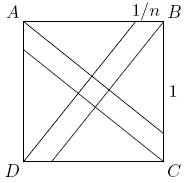1985 AIME Problems/Problem 4
Problem
A small square is constructed inside a square of area 1 by dividing each side of the unit square into ![]() equal parts, and then connecting the vertices to the division points closest to the opposite vertices. Find the value of
equal parts, and then connecting the vertices to the division points closest to the opposite vertices. Find the value of ![]() if the the area of the small square is exactly
if the the area of the small square is exactly ![]() .
.
Solution
The lines passing through ![]() and
and ![]() divide the square into three parts, two right triangles and a parallelogram. The area of the triangles together is easily seen to be
divide the square into three parts, two right triangles and a parallelogram. The area of the triangles together is easily seen to be ![]() , so the area of the parallelogram is
, so the area of the parallelogram is ![]() . By the Pythagorean Theorem, the base of the parallelogram has length
. By the Pythagorean Theorem, the base of the parallelogram has length  , so the parallelogram has height
, so the parallelogram has height ![]() . But the height of the parallelogram is the side of the little square, so
. But the height of the parallelogram is the side of the little square, so ![]() . Solving this quadratic equation gives
. Solving this quadratic equation gives ![]() .
.
See also
| 1985 AIME (Problems • Answer Key • Resources) | ||
| Preceded by Problem 3 |
Followed by Problem 5 | |
| 1 • 2 • 3 • 4 • 5 • 6 • 7 • 8 • 9 • 10 • 11 • 12 • 13 • 14 • 15 | ||
| All AIME Problems and Solutions | ||










